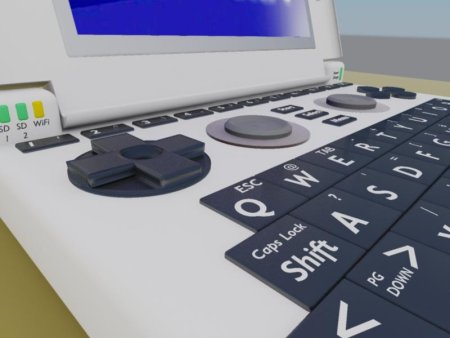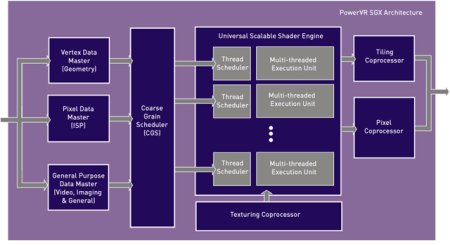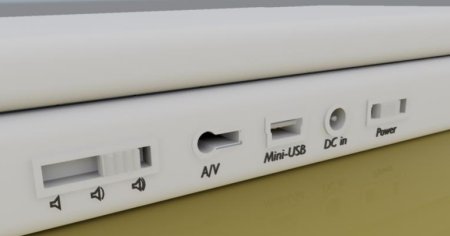Could Pandora open up Linux games?
Jan 29, 2008 — by Eric Brown — from the LinuxDevices Archive — 7 views [Updated Mar. 3, 2008] A stealth-mode startup is readying a Linux-based handheld gaming device with WiFi, USB, and a 4.3-inch 800×480 touchscreen. The “Pandora,” headquartered at OpenPandora.org for now, runs Linux on a next-generation ARM SoC with integrated OpenGL 2.0 compliant graphics processor.
[Updated Mar. 3, 2008] A stealth-mode startup is readying a Linux-based handheld gaming device with WiFi, USB, and a 4.3-inch 800×480 touchscreen. The “Pandora,” headquartered at OpenPandora.org for now, runs Linux on a next-generation ARM SoC with integrated OpenGL 2.0 compliant graphics processor.
(Click for larger view of Pandora)
digg this story |
Powered by a lithium-ion battery, Pandora measures 5.5 x 3.3 x 1.1 inches — slightly smaller than Nintendo's DS Lite, or GamePark Holdings's Linux-based GP2X player, from which it arguably evolved. In terms of processing power, its designers claim Pandora will compare to Nintendo's GameCube, a non-mobile gaming platform.
OpenPandora.org was launched last year by “CraigIX” and “EvilDragon,” both members of Gamepark Holdings's GP2X gaming community. The two launched the site and began working on Pandora after GamePark Holdings released its second-generation handheld gaming platform, the GP2X F-200. Thus, the Pandora appears to be positioned as a more powerful successor to the GP2X, a leading (and one of the only) Linux-based game platforms.
Since few games are available for native Linux, GP2X supports a variety of game emulators, including MAME, SNES, Genesis, and PC Engine. This lets users enjoy a variety of game titles originally written for other platforms. Pandora will initially offer full-speed PlayStation 1 emulation, says the group, with N64 emulation planned in a later release.

Pandora keyboard
(Click to enlarge)
The Pandora is based on TI's recently-announced OMAP3530, one of the first available system-on-chip processors built on 65 nanometer process technology, and one of the first based on ARM's next-generation Cortex-A8 architecture. Chips based on Cortex-A8 can out-perform ARM11-based chips by up to three times, according to ARM.

Pandora (back, closed)
(Click to enlarge)
The OMAP3530 embeds Imagination Technologies's PowerVR SGX graphics core, making it “the first applications processor to support OpenGL ES 2.0 and OpenVG,” according to TI. OpenGL ES 2.0 enables 3D graphics processing at several million polygons per second, says OpenPandora. The low-power PowerVR SGX is designed specifically for processing 3D graphics and video on wireless-equipped mobile devices. Built around a tile-based, scalable, multi-threaded processing engine, the processor is touted as being able to encode and decode video at DVD resolutions.
The Pandora is equipped with 128MB of DDR SDRAM and 256MB of internal flash, and sports a 4.3-inch display offering a 5:3 aspect ratio. The device includes 802.11g WiFi, a USB host, dual SDHC slots, and a serial port. It includes a QWERTY keyboard and microphone, as well as TV-out, A/V-out, and headphone/microphone input. Game controls include a directional pad and two analog nubs, with rubber grip and click function.

PowerVR SGX architecture
(Click to enlarge)
The Pandora is loaded with “Open2X-style” Linux firmware, says OpenPandora, but notes that Debian ARM packages will “probably” be accepted. Open2X was designed to support the GP2X, and currently runs on a Linux 2.4.26 kernel; a much newer kernel will likely be needed for the OMAP3430.
The Pandora can run X11 with a window manager and desktop environment, says OpenPandora, and it can also run most modern Linux programs, including Firefox 3.0. Macromedia Flash may not work, they say, but most Flash videos can be viewed using Gnash. Open source media players like mplayer and VideoLAN's VLC are also said to be able to run on Pandora.
 Pandora (red model) (Click to enlarge) |
Here are the specs for the Pandora:
- Processor — TI OMAP3530 with PowerVR SGX GPU
- Memory — 128MB DDR SDRAM; 256MB internal flash
- Flash memory expansion — 2 x SDHC
- Display — 4.3 inch touchscreen LCD with 800×480 resolution and 5:3 aspect ratio; 300 cd/m2 brightness; 450:1 contrast ratio
- I/O — 802.11g WiFi, USB host, RS232 serial
- A/V I/O — TV-out (supports picture-in-picture); A/V-OUT (S-Video and Composite); 3.5mm headphone/microphone cables
- Other features — directional pad; 2 x analog nubs, real-time clock
- Dimensions — 5.5 x 3.3 x 1.1 inches (140 x 83 x 27 mm)
- Battery — Lithium-ion; chargeable via AC adapter or USB port
- Operating system — Open2X-style Linux firmware

Pandora (front, detail)
(Click to enlarge)
Availability
The Pandora is expected to ship in April or May at a price of about $320 US (excluding VAT) or 100 GBP/286 Euros (including VAT). More information can be found on this developer-oriented page, but the official OpenPandora site is still pretty bare bones.
This article was originally published on LinuxDevices.com and has been donated to the open source community by QuinStreet Inc. Please visit LinuxToday.com for up-to-date news and articles about Linux and open source.